GLBenchmark 2.5 Performance on Modern Android Smartphones & Tablets
by Anand Lal Shimpi & Brian Klug on July 31, 2012 10:00 AM EST- Posted in
- Smartphones
- GLBenchmark
- Mobile
- Tablets
- SoCs
For quite a while now, GLBenchmark has been a regular test in our smartphone, tablet, and SoC reviews. As GPU performance has steadily increased, GLbenchmark 2.1.x started hitting vsync more of the time in onscreen tests, necessitating an updated version of the test with heavier assests, reworked rendering code, and improved functionality for testing. Today Kishonti Informatics has released GLBenchmark 2.5.0 both on the Google Play store and to partners, and we're taking a first look at performance across the current crop of devices.
GLBenchmark 2.5.0 primarily addresses a few shortcomings from the previous version of the Egypt test, primarily by moving to a more challenging version of Egypt. The new game test is named Egypt HD, and moves to a much more complex scene while keeping roughly the same test animation. Geometry count has increased, texture resolution has increased, there's a new water shader, more reflections, and more shadowing. In addition, the offscreen test has now moved to a default resolution of 1080p instead of the previous 720p, for a more challenging workload. This offscreen resolution is now customizable, but we'll be running 1080p for ease of comparison. In addition, the "classic" Egypt test is also a part of GLBenchmark 2.5.0 for those wishing to compare to 2.1.5. In addition, the triangle and fill subtests also stay around for a lower level look at OpenGL ES 2.0 performance. It should go without saying, but GLBenchmark 2.5 is still an OpenGL ES 2.0 test.
We've run GLBenchmark 2.5.0 on all the devices we have on hand, and have split up the results between tablets and smartphones for ease of comparison. The iOS version of GLBenchmark 2.5.0 is still in the review process, and we'll be updating as soon as we can run that on our iPhone 4S, iPad 2, and iPad 3. For now however, we have a good look at performance for the latest devices in Android land.
Tablets
We have three major SoCs making up our tablet test candidates: NVIDIA's Tegra 3, NVIDIA's Tegra 2 and TI's OMAP 4430. When we get the iOS versions of GLBenchmark 2.5 we'll be able to add the A5 and A5X to this list. We're also waiting on our own Qualcomm MDP/T, which will let us add Adreno 320 results in a few weeks.
The fill and triangle rate tests show us just how far we've come since the days when Tegra 2 and the PowerVR SGX 540 were considered cream of the crop. NVIDIA's Tegra 3 is just significantly faster across the board. The Transformer Pad Infinity's added memory bandwidth (DDR3-1600) helps propel it above the other, lesser Tegra 3 configurations. Again there's nothing new here, just new data that validates what we've already known.
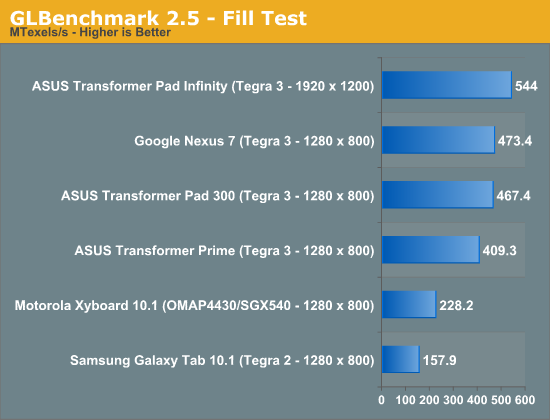
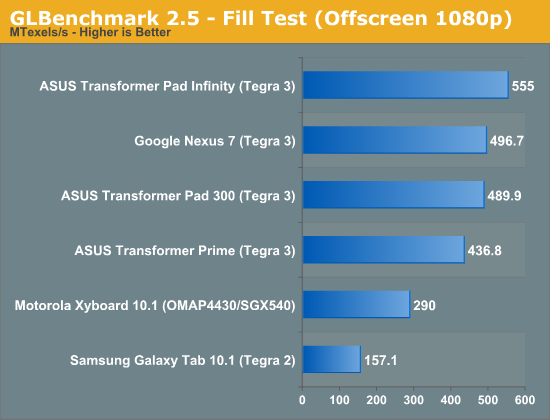
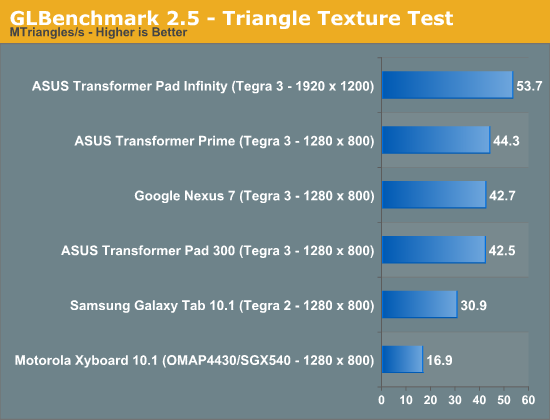
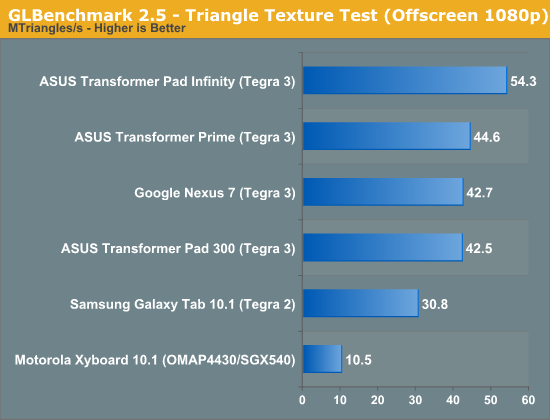
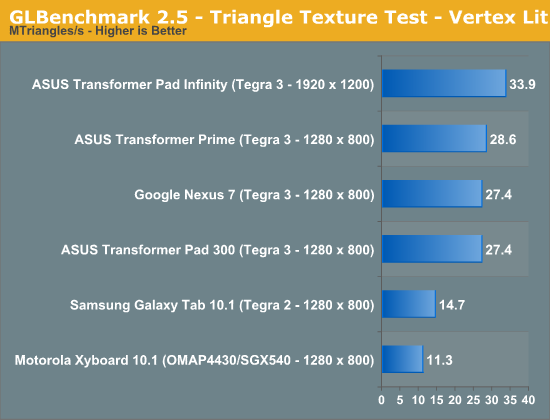
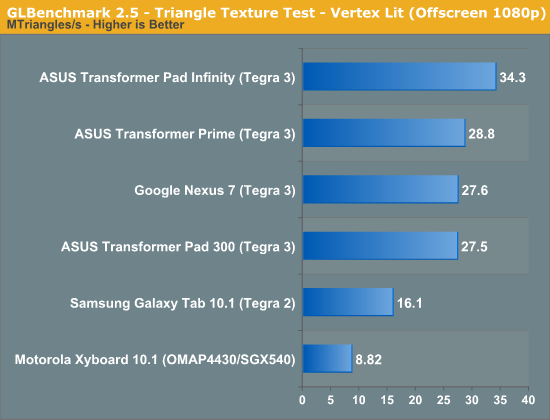


The Egypt HD test raises the bar for what is necessary to produce playable frame rates. At their native resolutions, none of these tablets can even deliver half of a playable 30 fps frame rate. For the next generation of games, we'll need performance around 3x better than NVIDIA's Tegra 3. Qualcomm's Adreno 320 has the ability to deliver that depending on the workload, so it's possible we may see > 30 fps results from it. The A5X should be able to break 30 fps as well, but we'll find out for sure in another day or so.
The offscreen results are even worse. Tegra 3 with DDR3-1600 is still only good for 11 fps. It shouldn't be any surprise, but we will need faster GPUs for better looking games. Egypt HD is definitely the new torture test for mobile SoCs.
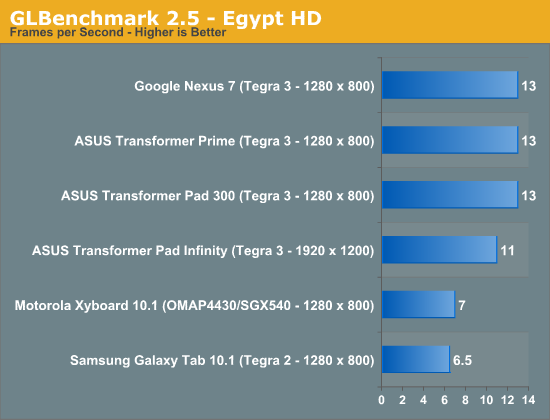
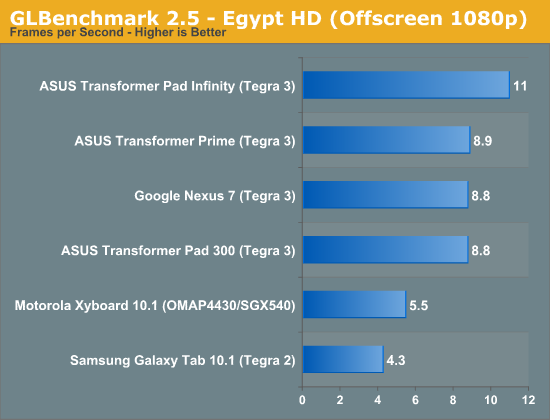
The Egypt Classic test ends up being Vsync limited on the 1280 x 800 Tegra 3 tablets, with even 1920 x 1200 running smoothly on the Transformer Pad Infinity. These numbers echo the reality of 3D gaming on Android today: pretty much everything runs well on Tegra 3.
The same can't be said for Tegra 2 or OMAP 4430 however, even at 1280 x 800 both of these SoCs deliver frame rates well below 30 fps.
The offscreen 1080p results paint a good picture for Tegra 3, which again can deliver average frame rates at or above 30 fps. Anything older than Tegra 3 however just can't pull it off.
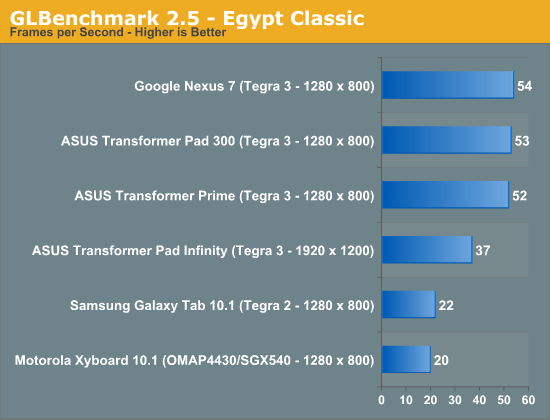



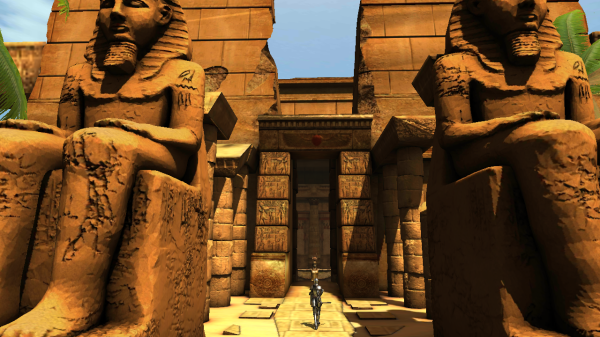














47 Comments
View All Comments
A5 - Tuesday, July 31, 2012 - link
My results fall in almost exactly with these running a ROM based on the VM ICS leak: https://glbenchmark.com/phonedetails.jsp?D=HTC+EVO...The offscreen+MSAA tests are still busted, but the rest of it seems to work.
Bateluer - Tuesday, July 31, 2012 - link
With the Galaxy Nexus, my ePenis feels inadequate. Next crop of Nexus devices better push the performance envelope.hurrakan - Tuesday, July 31, 2012 - link
I was going to buy a Samsung Galaxy S3 here in the UK, but is it really utter crap compared to the US version?aruisdante - Tuesday, July 31, 2012 - link
It's just different. Mali400 is very good in pixel-shader heavy situations. And Exynos Quad is better than S4's current dual core Krait implementation in highly threaded environments.The problem is that a lot of current workloads are neither of those things. In day to day tasks, raw processor performance between quad-core A9 (Exynos Quad, Tegra-3) and dual core Krait (Snapdragon S4) works out to be roughly equal, because Krait is about 30% faster Clock per Clock and runs a about 20% higher clockspeeds thanks to its 28nm construction. Since most workloads are not highly threaded, Krait's increased single-threaded performance is enough to overcome the quad-core's core advantage.
Pipperox - Tuesday, July 31, 2012 - link
Not quite.First of all, synthetic benchmarks can be very misleading as they selectively stress certain components in isolation, and they're also prone to cheating i.e. benchmark specific optimizations which bring nothing for real world performance.
In the PC industry they've been practically abandoned in reviewing new graphic cards, in favor of game benchmarks.
The Mali400 in the SGS III international version has by far the highest fill rate, 3x compared to Adreno, which in turn has a much higher triangle throughput, according to this test.
But the thing is, there aren't few if any games out there which come close to the polygon count of the Egypt Classic scenario.
Egypt HD is rather extreme, and more of a view of things to come, but with no smartphone significantly breaking the barrier of 20 fps (and if you run the benchmark, you see how the frame rate dips often to 5fps or less), it's unlikely that we'll see anything remotely comparable in the next couple of years.
So for the games out there and in the near future, Mali400 is king.
dagamer34 - Tuesday, July 31, 2012 - link
A big problem is that any 3D-heavy game that you'd want to use for benchmarking on Android is basically fully optimized to a specific chipset, to the point that nVidia and Qualcomm heavily assist developers who use their chips in exchange for prominent placing in TegraZone and GameCommand respectively.I feel that the great equalizer in the SoC wars will be Windows RT, since one binary will have to run on a Tegra 3, Snapdragon S4, and OMAP4, so the chances of cheating will likely be diminished.
metafor - Tuesday, July 31, 2012 - link
Of course, with modern games that are mostly fill-rate bound, all these GPU's have little trouble hitting the 60fps barrier. So while fill-rate monster GPU's can indeed win in off-screen, non-vsync'ed benchmarks, it's really kinda moot.Lucian Armasu - Tuesday, July 31, 2012 - link
It seems they made the Egypt tests at least twice more aggressive than they should've been in this release. It's kind of ridiculous that all the latest GPU's can't even get past 15 FPS in it. I mean, what's the point of showing something like that? Might as well make the app for latest PC gaming hardware.So yeah, I think this version of Egypt is too aggressive, especially since we know they are going to launch GLBenchmark 3.0 for OpenGL ES 3.0 this fall. What are they going to do when they have to add all the extra graphics features of OpenGL ES 3.0 on top of the new very complex Egypt text? Will they just make all the new GPU's show 5 FPS in their tests?
This is definitely wrong.
Mike1111 - Tuesday, July 31, 2012 - link
"It's kind of ridiculous that all the latest GPU's can't even get past 15 FPS in it."A5X and Adreno 320 weren't tested yet. And the next generation of mobile GPUs coming in early 2013 will be much more powerful.
A5 - Tuesday, July 31, 2012 - link
http://glbenchmark.com/phonedetails.jsp?benchmark=...A5X roughly triples the Fill Test of the Tegra 3. It also gets about 50 fps on the Offscreen test in Egypt HD.
If anything, I'd say they didn't make it stressful enough.